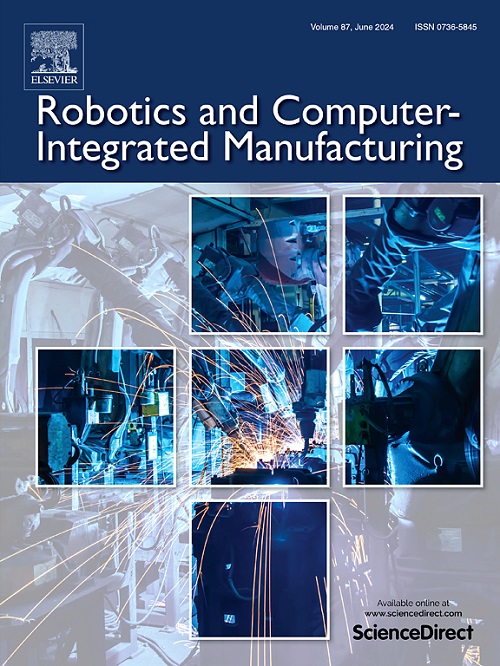A parameter separation-based method for kinematic identification of industrial robots without prior kinematic information
IF 11.4
1区 计算机科学
Q1 COMPUTER SCIENCE, INTERDISCIPLINARY APPLICATIONS
引用次数: 0
Abstract
Accurate kinematic parameters are crucial for deploying industrial robots in high-precision manufacturing applications, such as machining workpieces. Traditional kinematic identification methods often assume that nominal parameter values are known and used as initial estimates. However, in industrial applications, obtaining such nominal values is challenging due to the limited access to detailed design data and the specialized knowledge required for kinematic modeling. This lack of prior kinematic information poses significant challenges to the accuracy and efficiency of parameter identification. To address these issues, we introduce a variable projection (VP) method that eliminates linear parameters through orthogonal projection, transforming the kinematic parameter identification problem into a nonlinear least squares problem involving only the nonlinear parameters. First, the separable structure of the kinematic model is explicitly derived. Then, a novel approach is proposed to integrate the separation of redundant parameters with the VP method. By focusing solely on non-redundant nonlinear parameters, the proposed method significantly reduces reliance on the accuracy of the initial estimates. Simulations and experiments demonstrate that the proposed method achieves more stable parameter estimates and faster convergence in the absence of prior kinematic information. Furthermore, the identified parameters are successfully applied for error compensation in a robotic machining case, leading to an 80% improvement in machining accuracy.
基于参数分离的无先验运动学信息工业机器人运动学辨识方法
精确的运动学参数对于在高精度制造应用中部署工业机器人至关重要,例如加工工件。传统的运动学辨识方法通常假设已知标称参数值,并将其作为初始估计值。然而,在工业应用中,由于获得详细设计数据和运动学建模所需的专业知识有限,获得这样的标称值是具有挑战性的。这种先验运动学信息的缺乏对参数识别的准确性和效率提出了重大挑战。为了解决这些问题,我们引入了一种变量投影(VP)方法,该方法通过正交投影消除线性参数,将运动参数辨识问题转化为只涉及非线性参数的非线性最小二乘问题。首先,明确地推导了运动学模型的可分离结构。然后,提出了一种将冗余参数分离与VP方法相结合的新方法。通过只关注非冗余非线性参数,该方法显著降低了对初始估计精度的依赖。仿真和实验表明,该方法在没有先验运动学信息的情况下,参数估计更稳定,收敛速度更快。将所识别的参数成功地应用于机器人加工实例的误差补偿,使加工精度提高了80%。
本文章由计算机程序翻译,如有差异,请以英文原文为准。
求助全文
约1分钟内获得全文
求助全文
来源期刊
CiteScore
24.10
自引率
13.50%
发文量
160
审稿时长
50 days
期刊介绍:
The journal, Robotics and Computer-Integrated Manufacturing, focuses on sharing research applications that contribute to the development of new or enhanced robotics, manufacturing technologies, and innovative manufacturing strategies that are relevant to industry. Papers that combine theory and experimental validation are preferred, while review papers on current robotics and manufacturing issues are also considered. However, papers on traditional machining processes, modeling and simulation, supply chain management, and resource optimization are generally not within the scope of the journal, as there are more appropriate journals for these topics. Similarly, papers that are overly theoretical or mathematical will be directed to other suitable journals. The journal welcomes original papers in areas such as industrial robotics, human-robot collaboration in manufacturing, cloud-based manufacturing, cyber-physical production systems, big data analytics in manufacturing, smart mechatronics, machine learning, adaptive and sustainable manufacturing, and other fields involving unique manufacturing technologies.

 求助内容:
求助内容: 应助结果提醒方式:
应助结果提醒方式:


